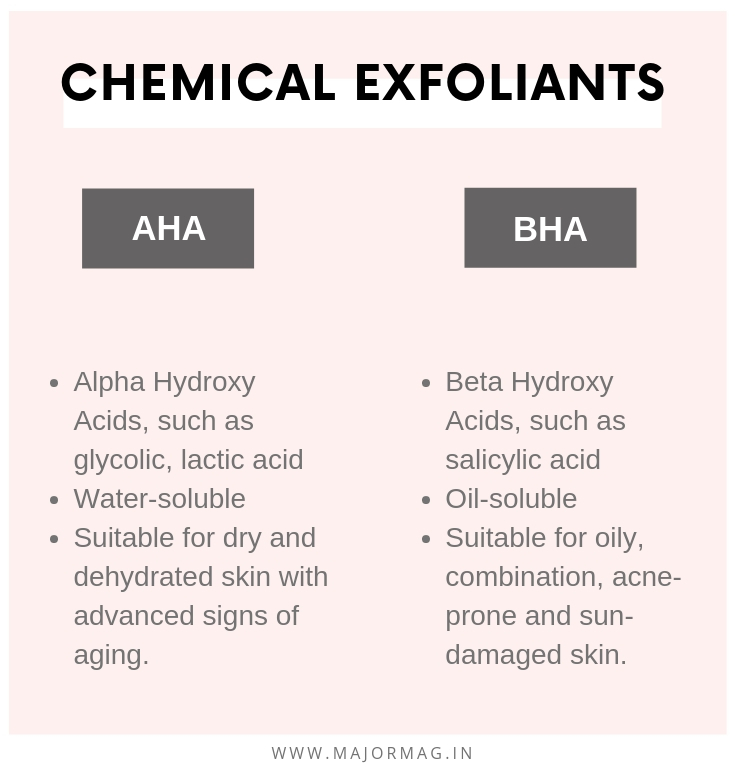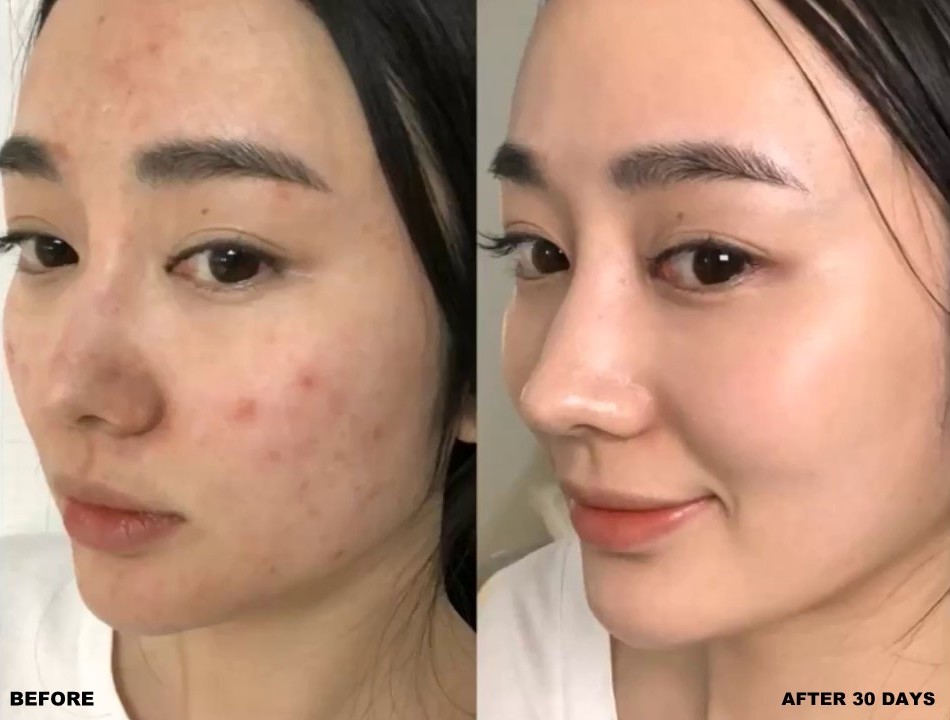Most people are familiar with physical exfoliation, but not everyone has heard of chemical exfoliation which basically promotes smoother skin by sloughing off dead skin cells and boosting cell turnover with the help of skincare acids.
Unlike physical exfoliants, chemical exfoliants require minimal effort but offer maximum benefit. They can be classified as two types: Alpha Hydroxy Acids, or AHA and Beta Hydroxy Acids, or BHA — what are they exactly? short answer, leave-on exfoliants.
AHAs, such as glycolic acid and lactic acid, are water-soluble and work on the skin’s surface, gently loosening the bonds between dead skin cells to reveal fresher, healthier skin. BHAs, typically salicylic acid, are oil-soluble and penetrate deeper into the pores, making them effective for treating acne and congested skin.
You might opt for a chemical exfoliant if you are looking for something that:
• Requires no scrubbing (great for sensitive and problem skin)
• Continues to work after application
• Works more deeply, and not just the top layers of skin
• Helps reduce signs of ageing
To some, the word ‘acid’ might seem a little scary, which is why we’ve broken down everything in this beginner’s guide…
What are AHAs?
Alpha Hydroxy Acids (AHAs) represent acids derived from a natural substance like sugar cane, milk, almonds, or grapes. Under the AHA banner are:
» Glycolic acid (derived from sugarcane);
» Lactic acid (derived from milk);
» Malic acid (derived from pears and apples);
» Citric acid (derived from oranges and lemons);
» Tartaric acid (derived from grape extracts).
All of these chemicals basically produce a slight chemical peel. That’s why many products are labeled “peel treatment,” “retexturizing peel,” or “peel pads,” (acid-soaked pads that you swipe over your face, then follow with another neutralizing pad containing moisturizing ingredients).
Typical concentrations range between 4-15%, although higher concentrations can be found in peels. For regular exfoliation, we generally recommend concentrations between 5-10%.
What are BHAs?
The most popular BHA – Beta Hydroxy Acid – in skincare is salicylic acid, derived from willow bark. BHAs have anti-inflammatory and antibacterial properties, and are ideal if you’re dealing with clogged pores, blackheads, whiteheads, blemishes, enlarged pores, or oily skin in general.
By exfoliating the inside of the pores, BHAs help prevent the formation of acne lesions and promote a smoother, bump-free skin texture. They also have the potential to regulate excess sebum production, making them beneficial for individuals with oily or combination skin types.

How are AHAs and BHAs different?
The purpose of both AHAs and BHAs is to exfoliate the skin, both acids have a rejuvenating effect on skin, and neither type is “better” than the other. Both are highly effective methods of deep exfoliation.
The main difference between the two is that AHAs are water-soluble and BHAs are oil-soluble so they can get deeper into the pores to remove excess sebum and dead skin cells. This means that BHAs are better able to penetrate oily, combination, acne-prone and sun-damaged skin while AHAs are more effective at exfoliating dry and dehydrated skin with advanced signs of aging.
Also, AHAs can be slightly more irritating than BHAs for sensitive skin due to their potential to increase skin sensitivity to the sun. BHAs are generally seen as the milder of the two options as they have a natural anti-inflammatory effect and feature a larger molecular weight when compared to AHAs.

Using AHA and BHA products together?
According to a 2009 study, AHAs and BHAs yield fuller skin when used together. Some products, like Proactiv’s Mark Correcting Pads, are formulated with both.
To make them work together, either use AHAs and BHAs on alternating days, or you can apply an AHA to dry areas and a BHA to oily areas of your skin. You can also alternate each week — One week is once or twice daily application of an AHA, the next week do the same, but with a BHA exfoliant.
For AHA exfoliants we recommend anywhere between five and ten percent. For BHAs, one to four percent is ideal, but occasionally up to nine percent for stubborn imperfections.
How often should I exfoliate?
Start with just one application a week: this will give your skin time to get used to the pH change, then slowly increase frequency.
If you have oily or combination skin that’s prone to acne, you may benefit from using a salicylic-acid-based exfoliant three to four times a week, depending on how your skin reacts. Most people with mature and tougher skin do fine exfoliating once daily.
Remember – as long as you have gentle, effective products, skin exfoliation is about experimentation and fine-tuning your routine as needed.
How to Use?
Use your chemical exfoliant (AHA/BHA) after cleansing and toning. Let the product sink in, then follow up with a moisturizer/serum. Your basic skincare routine should look like this: Cleanse > Exfoliate > Moisturize (SPF in the day)
Chemicals! Sometimes, they’re your friends. Here are some of the best chemical exfoliators to get you started…
1. The Ordinary Lactic Acid 10% + HA 2%. Buy It: $6.80, sephora.com
2. Kate Somerville Liquid ExfoliKate® Triple Acid Resurfacing Treatment with 10% AHA. Buy It: $58, sephora.com
3. Pixi by Petra Glow Tonic with 5% Glycolic Acid. Buy It: $15, pixibeauty.com
4. Paula’s Choice Skin Perfecting 2% BHA Liquid Exfoliant. Buy It: $29.50, paulaschoice.com
5. Dr. Dennis Gross Skincare Alpha Beta Extra Strength Daily Peel (60 count). Buy It: $130-$150, dermstore.com
6. The Ordinary AHA 30% + BHA 2% Peeling Solution. Buy It: $7.20, sephora.com
PLEASE NOTE
» When starting on any types of exfoliators, you should ease it into your routine. Some can use AHA & BHA layered and multiple times daily, while others can only use it a few times a week. So, start slow!
» If your skin is sensitive, avoid layering AHAs and BHAs on top of one another. Both of these are exfoliators, so layering them can cause dryness and irritation.
» The types of chemical exfoliators used over the counter are nowhere near as harsh as professional peels.
» It is VERY important to use a broad spectrum (SPF 30+) sunscreen after incorporating acids into your skincare regimen. This is critical to the success of any chemical exfoliant, not to mention your skin’s overall health.
» Sunscreen must always be the final step in your daytime skincare routine. Any skin care product you apply over a sunscreen dilutes and reduces its effectiveness.
» Skin purging is a process where an active ingredient (such as AHA & BHA) that increases cell turnover, can cause what resembles a breakout! This typically lasts for about 3-4 weeks, so stick with your exfoliator for at least 4-6 weeks to see its benefits.
» If you’re using a topical prescription product such as retinol, read this guide on how to combine retinol and acids into a skincare routine.
You may also like
- Why Retinol Deserves a Spot in Your Skincare Routine
- Physical and Chemical Exfoliation: What’s the difference
- 3 Ways To Perfect Your Going-Out Makeup With Skin Care
For more on fashion & beauty, follow Major Mag on Instagram and Pinterest.
